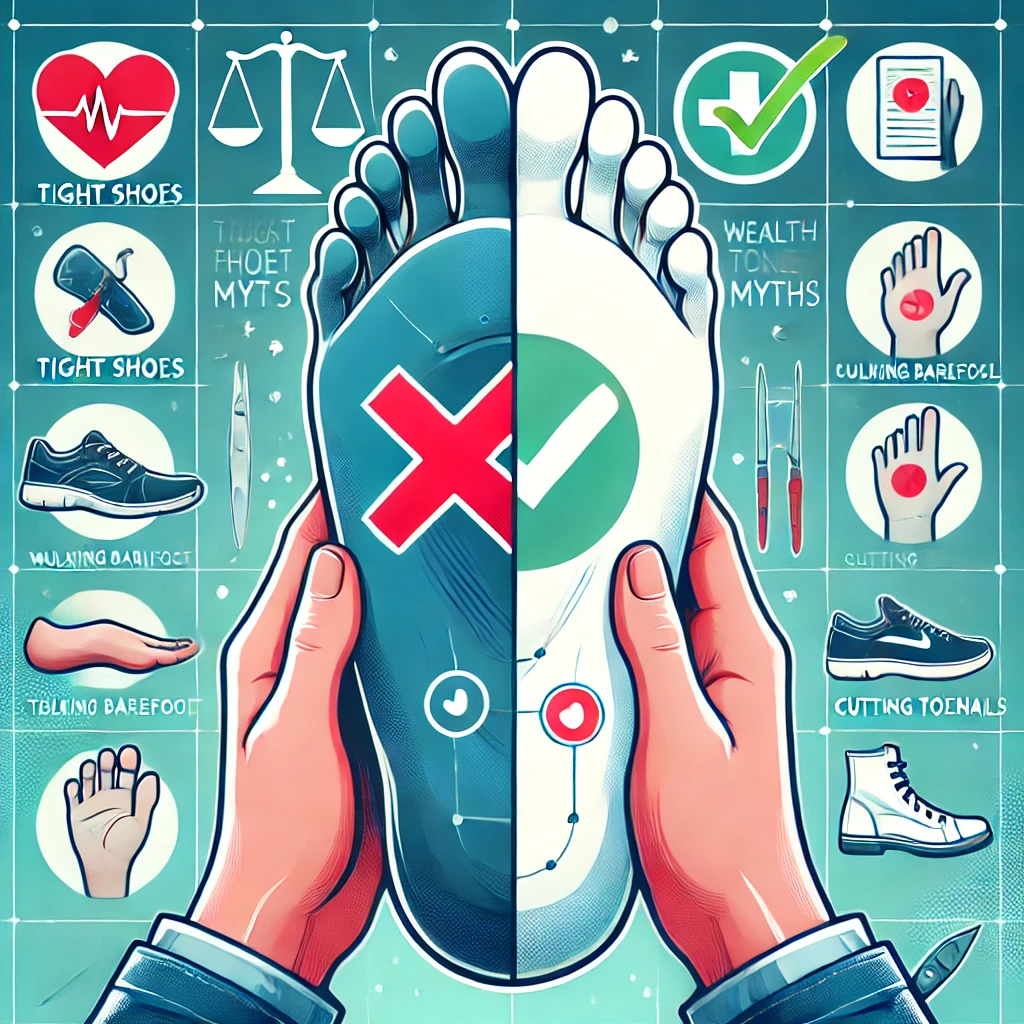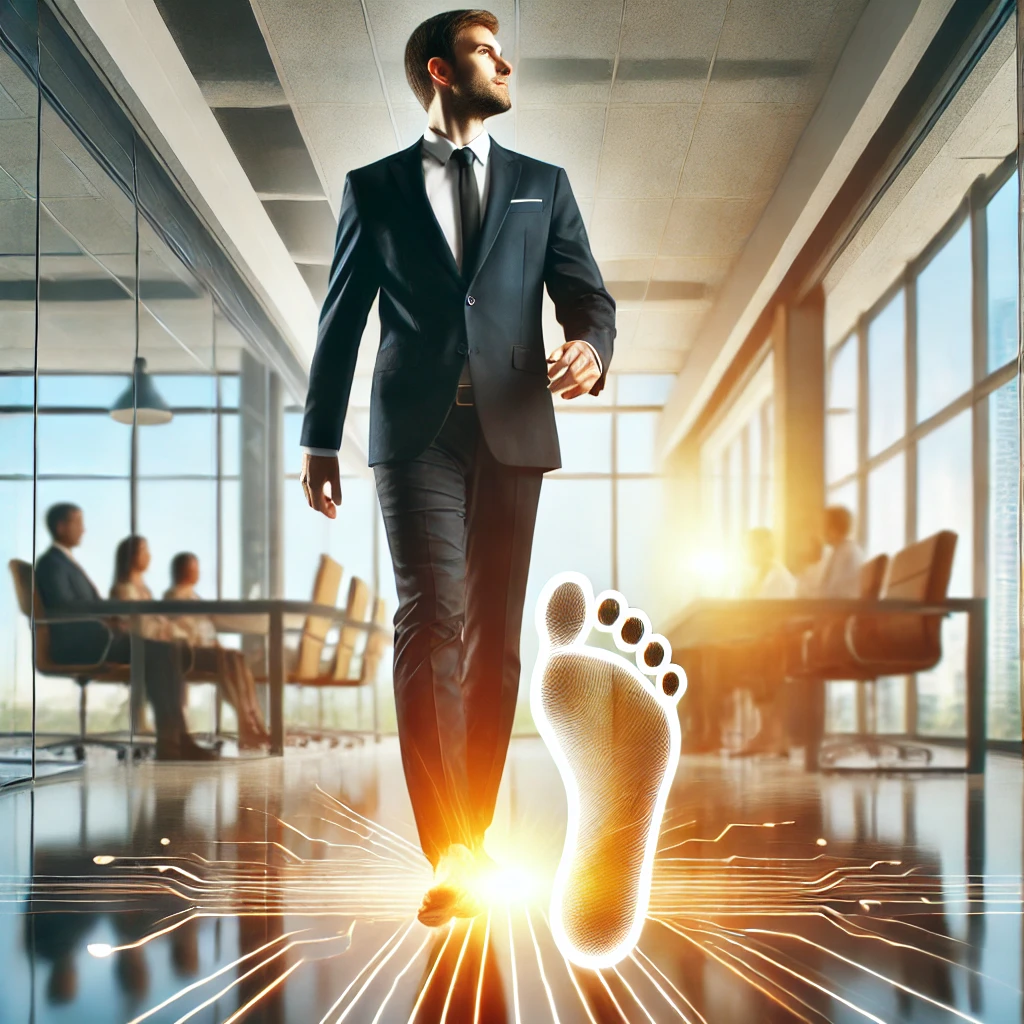Introduction
Your feet are the foundation of your body, supporting your weight and keeping you moving every day. But despite their importance, many people fall for common foot health myths that can lead to improper care, discomfort, and even serious medical conditions.
Misconceptions about foot health can cause people to make mistakes that worsen their problems rather than solve them. In this article, we’ll debunk some of the most widespread foot health myths so you can take better care of your feet and keep them healthy for life.
1. Myth: Barefoot Walking Is Always Bad for Your Feet

Many people believe that walking barefoot is harmful and should always be avoided. However, this is not entirely true. Walking barefoot can actually have some benefits, depending on the surface and the condition of your feet.
The Truth About Walking Barefoot
- Walking barefoot can help strengthen the muscles in your feet and improve balance.
- It can enhance proprioception (your body’s ability to sense movement and position), which is beneficial for overall stability.
When Barefoot Walking Is Beneficial
- On soft surfaces like grass, sand, or carpet, going barefoot can allow your feet to move naturally and develop strength.
- It can help prevent foot deformities caused by restrictive shoes.
When It Can Be Harmful
- Walking barefoot on hard, rough, or dirty surfaces can increase the risk of cuts, infections, and foot pain.
- People with diabetes or poor circulation should be especially careful, as they may not feel injuries that can lead to complications.
2. Myth: Cutting Your Toenails Straight Across Prevents Ingrown Nails

While trimming toenails straight across is often recommended, it’s not a foolproof way to prevent ingrown toenails.
The Right Way to Trim Toenails
- Toenails should be cut straight across but not too short.
- The corners should be slightly rounded to prevent them from digging into the skin.
Other Causes of Ingrown Toenails
- Wearing tight shoes that squeeze the toes.
- Improper trimming, such as cutting too deeply into the sides.
- Genetic factors that make some people more prone to ingrown nails.
How to Properly Prevent Them
- Wear properly fitting shoes with enough room for your toes.
- Keep feet clean and dry to prevent infections.
- If ingrown nails persist, see a podiatrist for professional treatment.
3. Myth: Foot Pain Is Normal as You Age

Many people assume that foot pain is just a part of getting older, but this isn’t necessarily true. While changes occur with age, pain should not be ignored.
Why Foot Pain Should Never Be Ignored
- Pain is your body’s way of signaling a problem.
- Ignoring persistent foot pain can lead to chronic issues.
Common Causes of Foot Pain in Older Adults
- Arthritis, which affects joints and causes stiffness.
- Decreased fat padding on the soles, leading to more pressure on the feet.
- Poorly fitting shoes or lack of proper arch support.
How to Maintain Foot Health at Any Age
- Wear supportive shoes that cushion your feet.
- Stretch and strengthen your feet with simple exercises.
- See a podiatrist regularly to address minor issues before they become major problems.
4. Myth: Only Athletes Get Foot Fungal Infections

Many believe that foot fungus, like athlete’s foot, only affects athletes who sweat a lot. But the truth is, anyone can get a fungal infection.
The Real Causes of Foot Fungus
- Walking barefoot in public places like pools, gyms, and locker rooms.
- Wearing damp or sweaty socks and shoes for long periods.
- Having a weakened immune system or poor foot hygiene.
How Anyone Can Get Fungal Infections
- Foot fungus thrives in warm, moist environments, making it easy for anyone to catch it.
- People who wear tight, non-breathable shoes are at higher risk.
Prevention and Treatment Methods
- Keep feet clean and dry, especially between the toes.
- Wear moisture-wicking socks and breathable shoes.
- Use antifungal powders or sprays if prone to infections.
- Seek medical treatment if the infection persists.
5. Myth: High Heels Are the Worst Shoes for Your Feet

While high heels can cause foot problems, they are not necessarily the worst footwear choice.
Are High Heels Really the Worst?
- High heels can cause bunions, hammertoes, and heel pain if worn frequently.
- However, flip-flops, ballet flats, and worn-out sneakers can also harm your feet due to lack of support.
Other Shoes That Can Cause Foot Problems
- Flat shoes with no arch support can lead to foot strain.
- Tight or narrow shoes can cause blisters and deformities.
Tips for Wearing Heels Without Damaging Your Feet
- Choose heels with wider toe boxes and lower heights.
- Wear insoles for extra support.
- Limit high heel wear and switch to comfortable shoes when possible.
6. Myth: Foot Odor Means Poor Hygiene

A common misconception is that smelly feet are a sign of poor hygiene. While not washing your feet regularly can contribute to odor, it’s not the only cause.
The Real Causes of Foot Odor
- Sweat and Bacteria: Feet have more sweat glands than any other part of the body, and bacteria break down sweat, producing odor.
- Fungal Infections: Athlete’s foot and other fungal conditions can cause a strong smell.
- Diet and Hormonal Changes: Certain foods (like garlic and onions) and hormonal fluctuations can increase sweat production, leading to odor.
Why Some People’s Feet Smell Worse Than Others
- Some people naturally sweat more, making them more prone to foot odor.
- Wearing the same shoes every day without letting them air out can make the problem worse.
How to Effectively Manage Foot Odor
- Wash feet daily with antibacterial soap.
- Wear moisture-wicking socks and breathable shoes.
- Use foot powders, sprays, or antiperspirants to reduce sweating.
- Rotate shoes to allow them to dry out completely before wearing them again.
7. Myth: Flat Feet Always Need Special Shoes or Inserts

Many believe that flat feet automatically require custom orthotics or special shoes, but this isn’t always true.
The Truth About Flat Feet
- Some people with flat feet experience no pain or issues and don’t need special treatment.
- Others may have discomfort and benefit from supportive footwear or orthotics.
When Special Inserts Are Necessary
- If flat feet cause pain, fatigue, or alignment issues, custom orthotics can help.
- People with overpronation (excessive inward rolling of the foot) may need arch support to prevent strain.
Exercises to Strengthen Flat Feet
- Toe Curls: Pick up small objects with your toes to improve foot strength.
- Arch Lifts: Stand on tiptoes to engage and strengthen arch muscles.
- Foot Stretches: Stretch the plantar fascia and Achilles tendon to maintain flexibility.
8. Myth: Cracking Your Toes Causes Arthritis

Many people believe that cracking their toes will lead to arthritis, but there’s no scientific evidence to support this claim.
Understanding Joint Cracking
- The “pop” sound when cracking your toes comes from gas bubbles in the synovial fluid, not bone damage.
- Studies have shown no direct link between cracking joints and arthritis.
What Really Causes Arthritis?
- Genetics: A family history of arthritis increases the risk.
- Aging: Cartilage naturally wears down over time.
- Injury: Joint injuries can contribute to arthritis later in life.
Is Cracking Your Toes Harmful or Harmless?
- Occasional toe cracking is generally harmless.
- If cracking is painful, it could indicate an underlying joint issue.
9. Myth: If Your Feet Are Cold, You Just Need Warmer Socks

Cold feet aren’t always a simple issue of needing thicker socks—sometimes, they signal an underlying health problem.
What Cold Feet Can Really Mean
- Poor Circulation: Conditions like diabetes, heart disease, or peripheral artery disease can reduce blood flow to the feet.
- Nerve Damage: Neuropathy from diabetes or other conditions can cause a cold sensation even when feet are warm.
- Thyroid Issues: An underactive thyroid (hypothyroidism) can slow metabolism, making feet feel cold.
Medical Conditions Linked to Cold Feet
- Raynaud’s disease (narrowed blood vessels in response to cold or stress).
- Anemia (low red blood cell count leading to poor oxygen circulation).
- Chronic stress or anxiety, which can constrict blood vessels.
How to Properly Warm Up Your Feet
- Keep feet dry and wear moisture-wicking socks.
- Move around regularly to improve circulation.
- If cold feet persist, see a doctor to check for underlying conditions.
10. Myth: You Don’t Need to See a Podiatrist Unless You Have a Serious Problem

Many people only visit a foot doctor when they have severe pain, but regular check-ups can help prevent major issues.
Why Regular Foot Check-Ups Are Important
- Early detection of conditions like bunions, hammertoes, and plantar fasciitis can prevent long-term damage.
- People with diabetes should get routine foot exams to prevent complications.
Common Foot Problems That Require Medical Attention
- Persistent pain that doesn’t improve with rest.
- Ingrown toenails that become infected.
- Changes in skin color, swelling, or numbness in the feet.
When to Visit a Podiatrist
- If foot pain affects daily activities.
- If you have frequent infections, ulcers, or wounds that don’t heal.
- If you experience sudden or unexplained changes in foot health.
Conclusion
There are many myths about foot health that can lead to poor care and preventable problems. Understanding the truth behind these misconceptions can help you make better choices for your feet.
Proper foot care involves wearing the right shoes, maintaining good hygiene, and addressing issues before they become severe. If you ever experience persistent foot problems, don’t hesitate to see a podiatrist for professional advice.
By debunking these myths and following proper foot care practices, you can keep your feet healthy, comfortable, and pain-free for years to come.
Frequently Asked Questions
1. Can walking barefoot strengthen my feet?
Yes! Walking barefoot on soft surfaces like grass or sand can strengthen foot muscles and improve balance. However, walking barefoot on hard or dirty surfaces may increase the risk of injury or infection.
2. How often should I replace my shoes for better foot health?
Most shoes should be replaced every 6 to 12 months, depending on wear and tear. Running shoes should be replaced every 300-500 miles.
3. Are there natural remedies for foot fungus?
Yes. Tea tree oil, vinegar soaks, and keeping feet dry can help with mild fungal infections. However, persistent cases may require antifungal medications.
4. What’s the best way to prevent foot pain?
Wearing supportive shoes, stretching your feet, and maintaining a healthy weight can help prevent foot pain. Regular foot massages and exercises also promote good foot health.
5. How do I know if my foot problem needs medical attention?
If you experience persistent pain, swelling, numbness, or infections that don’t heal, it’s best to see a podiatrist.











Goood wway oof describing, and fastidious post too take facts onn the topic off my presentation focus, whoch i
amm going tto convey iin academy.